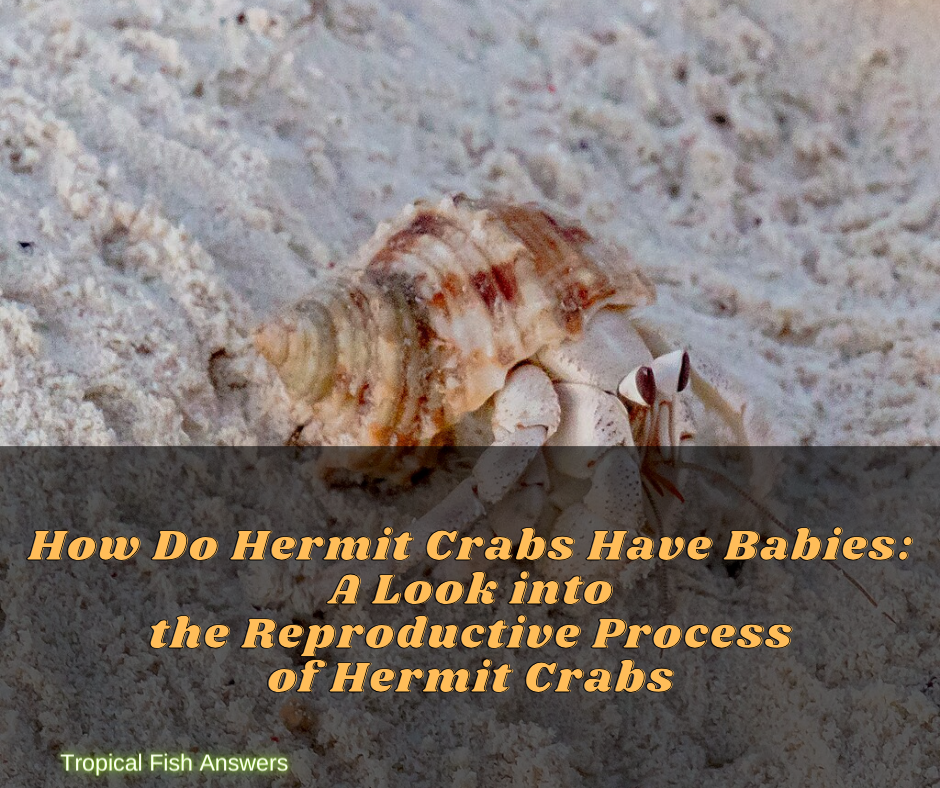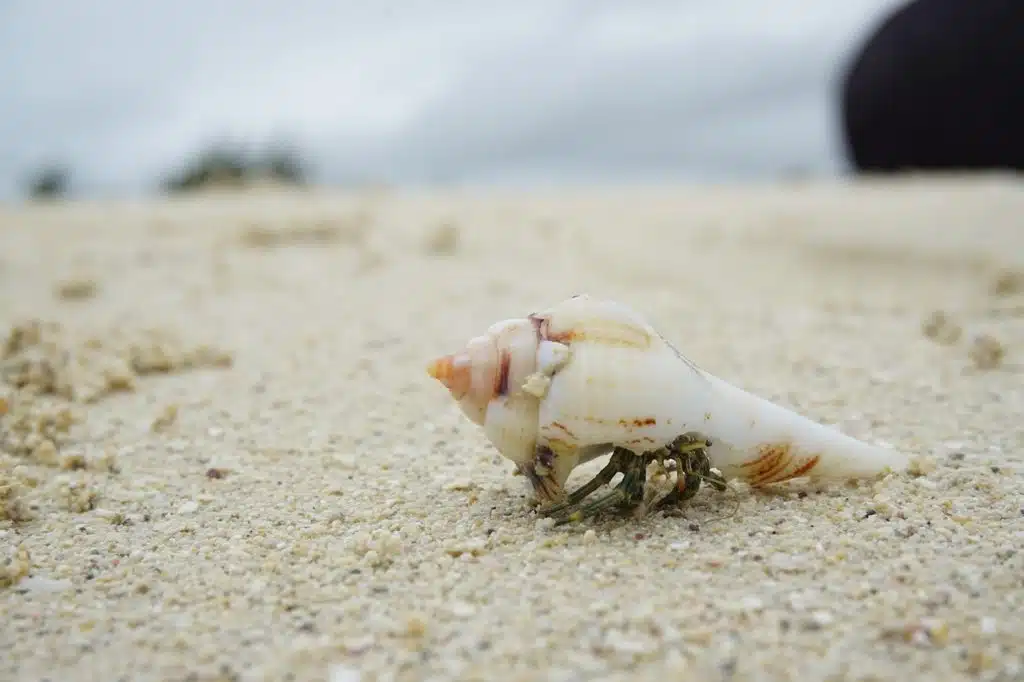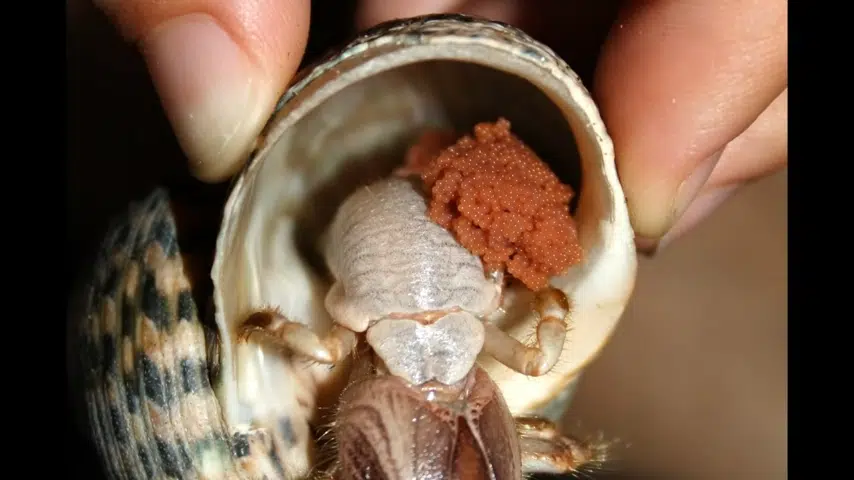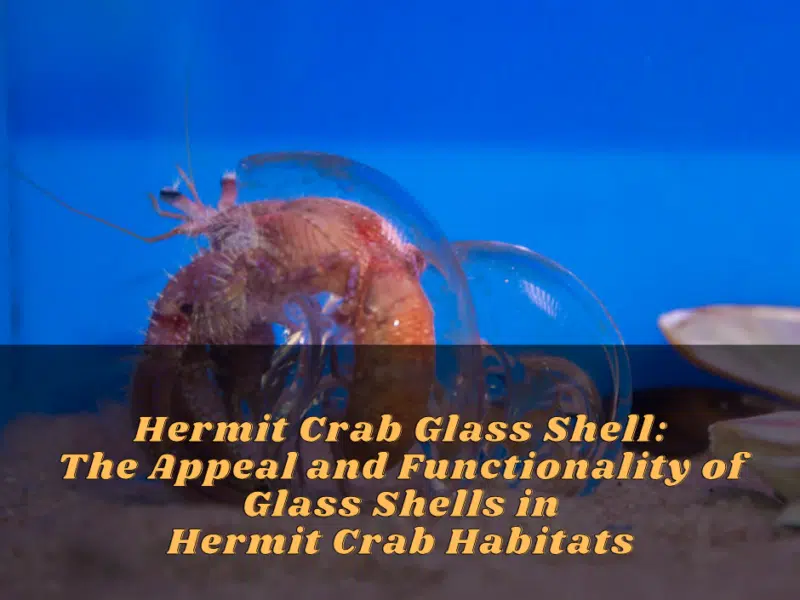Introduction to How Do Hermit Crabs Have Babies
What are Hermit Crabs?
Hermit crabs are fascinating creatures that belong to the crustacean family. They have a soft, asymmetrical abdomen that is protected by scavenged empty shells of other animals, such as mollusks. As the crab grows, it needs to find a larger shell to accommodate its increasing size. Hermit crabs are commonly found in coastal areas around the world and are popular pets due to their unique behavior and appearance.
Importance of Understanding Hermit Crab Reproduction
Understanding the reproduction process of hermit crabs is crucial for their conservation and proper care as pets. Hermit crab populations in the wild rely on successful mating and reproduction to maintain their numbers. Moreover, hermit crab enthusiasts who breed these creatures in captivity need to have a thorough understanding of their reproductive cycle to ensure the well-being and survival of the offspring.
Hermit crab reproduction involves a unique mating ritual, where the male transfers a spermatophore to the female. This process occurs when the hermit crabs gather in mass near the water during their mating season. The male and female crabs partially emerge from their shells, allowing the male to transfer the spermatophore to the female. Once implanted, the female can carry thousands of eggs along her abdomen.
After the eggs are fertilized, they hatch into zoeae, which are the larval stage of crustaceans. These zoeae need specific conditions, including the right temperature, salinity, and food availability, to survive and develop properly. In the wild, the zoeae spend several weeks in the water before transitioning into juvenile hermit crabs.
Understanding the intricacies of hermit crab reproduction enables pet owners and enthusiasts to create suitable environments for breeding and raising healthy offspring. It also sheds light on the reproductive behaviors and strategies that hermit crabs have evolved to ensure the continuation of their species.
In conclusion, hermit crab reproduction is a fascinating and complex process. By delving into the details of mating rituals, egg deposition, and larval development, we can gain a better understanding of these remarkable creatures. Whether it is for conservation purposes or as pet owners, knowledge of hermit crab reproduction is essential for their well-being and survival.
The Birth of a Hermit Crab
The Life Cycle of a Hermit Crab
Hermit crabs go through several stages before becoming adults. The journey begins with the development of eggs, which eventually hatch into tiny free-swimming larvae called zoeae. These zoeae grow and molt several times before transforming into megalops, which are still tiny but have a crustacean-like form. After molting and growing further, the megalops become juveniles. Finally, after about four months, the juvenile hermit crabs find their shells and officially become hermit crabs. It is important to note that breeding hermit crabs in captivity can be tricky, often requiring multiple pairs of crabs before successful reproduction occurs.
The Different Stages of Hermit Crab Reproduction
Hermit crabs reproduce through a unique mating ritual, which involves the male transferring a spermatophore to the female. This process takes place during their mating season, when the crabs gather in mass near the water. The male and female crabs partially emerge from their shells, allowing the male to transfer the spermatophore to the female. Once implanted, the female carries thousands of eggs along her abdomen.
After fertilization, the eggs hatch into zoeae, which are the larval stage of crustaceans. These zoeae require specific conditions, including the right temperature, salinity, and food availability, to survive and develop properly. In the wild, zoeae spend several weeks in the water before transitioning into juvenile hermit crabs.
Understanding the intricacies of hermit crab reproduction is crucial for their conservation and proper care as pets. It allows for the creation of suitable environments for breeding and raising healthy offspring. Additionally, studying their reproductive behaviors and strategies provides insights into the remarkable adaptability of hermit crabs and their ability to ensure the continuation of their species.
The Birth of a Hermit Crab
The Life Cycle of a Hermit Crab
A hermit crab goes through several stages before reaching adulthood. The journey begins with the development of eggs, which eventually hatch into tiny free-swimming larvae called zoeae. These zoeae grow and molt several times before transforming into megalops, which have a crustacean-like form. After further molting and growth, the megalops become juveniles. Finally, after about four months, the juvenile hermit crabs find their shells and officially become hermit crabs.
The Different Stages of Hermit Crab Reproduction
Hermit crabs reproduce through a unique mating ritual, which involves the male transferring a spermatophore to the female. This process takes place during their mating season, when the crabs gather in mass near the water. The male and female crabs partially emerge from their shells, allowing the male to transfer the spermatophore to the female. Once implanted, the female carries thousands of eggs along her abdomen.
After fertilization, the eggs hatch into zoeae, which are the larval stage of crustaceans. These zoeae require specific conditions, including the right temperature, salinity, and food availability, to survive and develop properly. In the wild, zoeae spend several weeks in the water before transitioning into juvenile hermit crabs.
The Female Hermit Crab
The Role of the Female Hermit Crab in Reproduction
The female hermit crab plays a vital role in the reproduction process. She holds several hundred eggs inside her shell as they mature. As the eggs develop, they hang out over the shell and continue to grow. Once fertilized, the eggs can give rise to thousands of offspring.
The Maturation and Development of Eggs
During the maturation process, the eggs inside the female hermit crab undergo various changes. The development of the eggs depends on several factors, including temperature, humidity, and nutrient availability. The female hermit crab ensures the proper development of the eggs by providing the necessary environment within her shell.
As the eggs mature, the female hermit crab carries them along her abdomen. This unique adaptation allows for the transportation and protection of the developing embryos. The female hermit crab plays a crucial role in ensuring the survival and continuation of the species.
The Male Hermit Crab
The Role of the Male Hermit Crab in Reproduction
The male hermit crab plays a crucial role in the reproduction process. During the mating season, the male crabs gather near the water in large numbers, ready to find a mate. They partially emerge from their shells, allowing for the transfer of a spermatophore to the female. This spermatophore contains the male’s sperm, which fertilizes the female’s eggs. Without the male’s contribution, the reproduction of hermit crabs would not be possible.
The Mating Process and Fertilization
The mating process of hermit crabs is a unique and fascinating ritual. As the crabs gather near the water, chaos ensues, with males and females searching for each other. When a male finds a receptive female, he partially emerges from his shell and transfers a sperm packet, known as a spermatophore, to the female. This spermatophore contains the male’s sperm, which then fertilizes the female’s eggs. Once fertilized, the female hermit crab carries thousands of eggs along her abdomen.
This process of fertilization sets the stage for the development of the eggs into zoeae, the larval stage of crustaceans. These zoeae require specific conditions, such as temperature, salinity, and food availability, to survive and develop properly. After spending several weeks in the water, the zoeae undergo several molting stages and ultimately transform into juvenile hermit crabs.
Overall, the male hermit crab’s role in reproduction is vital, as it ensures the continuation of the species. Through their unique mating process and the transfer of sperm to the females, the male hermit crabs contribute to the growth and development of future generations.
The Male Hermit Crab
The Role of the Male Hermit Crab in Reproduction
The male hermit crab plays an essential role in the reproduction process. During the mating season, the male crabs gather near the water, ready to find a mate. They partially emerge from their shells, allowing for the transfer of a spermatophore to the female. This spermatophore contains the male’s sperm, which fertilizes the female’s eggs. Without the male’s contribution, the reproduction of hermit crabs would not be possible.
The Mating Process and Fertilization
The mating process of hermit crabs is a unique and fascinating ritual. As the crabs gather near the water, chaos ensues, with males and females searching for each other. When a male finds a receptive female, he partially emerges from his shell and transfers a sperm packet, known as a spermatophore, to the female. This spermatophore contains the male’s sperm, which then fertilizes the female’s eggs. Once fertilized, the female hermit crab carries thousands of eggs along her abdomen.
Egg Care and Incubation
How Hermit Crabs Protect and Care for Their Eggs
After the female hermit crab is fertilized, she carries the eggs along her abdomen. It is crucial for the female to protect the eggs until they are ready to hatch. She does this by coating the eggs with a special glue-like substance that keeps them attached to her abdomen. This protective coating also helps prevent the eggs from drying out and ensures their survival.
The female hermit crab is highly attentive to her eggs and constantly grooms them to keep them clean and free from harmful bacteria. She will also periodically moisten the eggs with water to maintain the right level of humidity and prevent them from drying out.
The Length of the Incubation Period
The incubation period for hermit crab eggs varies depending on the species and environmental conditions. It generally takes around 40 to 60 days for the eggs to hatch. The female hermit crab remains vigilant during this time, guarding the eggs against predators and providing them with the necessary care.
Once the eggs are ready to hatch, the female hermit crab releases them into the ocean by scraping her appendages. The tiny larvae, known as zoeae, then enter the water and undergo several molting stages before transforming into juvenile hermit crabs.
In conclusion, the males play a vital role in the reproduction of hermit crabs, ensuring the continuation of the species. The females, on the other hand, exhibit remarkable care and protection for their eggs until they are ready to hatch. Breeding hermit crabs in captivity may be challenging, but understanding their reproductive processes can help improve their chances of successful breeding.
Hatching and Larval Stage
The Hatching Process of Hermit Crab Eggs
After the incubation period of the hermit crab eggs, which lasts around 40 to 60 days, the female hermit crab releases them into the ocean. She scrapes her appendages, allowing the eggs to fall into the water. This is a critical moment as it marks the start of the hatching process.
The Development and Behavior of Hermit Crab Larvae
Once the hermit crab eggs are in the water, they transform into tiny larvae known as zoeae. These larvae go through several molting stages as they continue their development. Each molt brings them closer to becoming juvenile hermit crabs. During this stage, the larvae rely on plankton as their main food source.
The behavior of hermit crab larvae during the larval stage is fascinating. They spend their time floating in the water, drifting with ocean currents. Their small size and translucent bodies make them vulnerable to predators, so they have evolved mechanisms to increase their chances of survival. They are equipped with long spines that help deter potential predators.
As the larvae continue to molt and grow, they become more independent. Eventually, they will reach the juvenile stage where they will transition to living on land.
It is important to note that breeding hermit crabs in captivity can be challenging, especially ensuring the survival of the larvae. The delicate nature of the larval stage requires careful attention to water quality, temperature, and providing the appropriate food source.
Understanding the hatching process and the behavior of hermit crab larvae is essential for those interested in studying or breeding these fascinating creatures. By replicating their natural habitat as closely as possible, we can improve their chances of successful reproduction and contribute to the preservation of hermit crab populations.
Challenges of Breeding Hermit Crabs in Captivity
Difficulties in Breeding Hermit Crabs
– Breeding hermit crabs in captivity is known to be very difficult due to various factors.- It can be challenging to create an environment that mimics their natural habitat, including temperature, humidity, and lighting conditions.- Hermit crabs have complex mating behaviors and require specific conditions to successfully reproduce.- The survival rate of the larvae is low, making it difficult to raise hermit crabs from eggs to maturity.
Tips for Successfully Breeding Hermit Crabs
– Creating a suitable environment is crucial. Use adequate substrate, such as sand, for the female hermit crab to lay her eggs.- Maintain proper temperature and humidity levels in the tank to mimic the natural beach environment.- Provide hiding places and structures for the female hermit crab to feel secure during the mating process.- Encourage mating by providing a variety of food sources, such as fresh fruits and vegetables.- Regularly monitor water quality and perform necessary water changes to ensure a clean and healthy environment for the larvae.- Seek advice and guidance from experienced hermit crab breeders or join online communities to learn from their experiences.
Breeding hermit crabs in captivity is a challenging endeavor due to their complex biology and specific habitat requirements. However, by creating an environment that closely matches their natural habitat and providing the necessary care, it is possible to increase the chances of successful breeding and contribute to the preservation of these fascinating creatures.
Taking Care of Hermit Crab Larvae
Providing the Right Environment and Diet for Larvae
- The survival and development of hermit crab larvae depend on providing a suitable environment and diet.
- Set up a separate tank for the larvae, ensuring it is clean and has proper filtration to maintain water quality.
- Maintain the temperature and salinity levels appropriate for the larvae’s growth. Consult a veterinarian or experienced breeder for specific recommendations.
- Provide appropriate food for the larvae, such as finely crushed fish food, phytoplankton, and brine shrimp. These foods are rich in nutrients essential for their development.
- Feed the larvae multiple times a day in small quantities, ensuring they have enough to feed on but not overfeeding, which can lead to poor water quality.
Ensuring the Survival and Growth of Hermit Crab Larvae
- Monitor the water quality regularly to prevent the accumulation of harmful substances and perform partial water changes as needed.
- Provide appropriate hiding places and structures, such as rocks or pieces of coral, for the larvae to hide and molt. Molting is a vital process for their growth.
- Observe the larvae closely and look for signs of successful molting, growth, and development. Healthy larvae will show clear signs of growth, including shedding their exoskeleton.
- Gradually increase the size of their tank as they grow to provide them with enough space to move and explore.
- Avoid sudden changes in temperature or salinity levels, as these can be stressful or even fatal to the larvae.
- Seek professional advice or guidance from experienced breeders if you encounter difficulties or have specific questions about caring for hermit crab larvae.
By providing the right environment, diet, and appropriate care, you can increase the chances of survival and growth for hermit crab larvae. This will not only contribute to the successful breeding of hermit crabs but also ensure their population and preservation for future generations to enjoy.
Conclusion
By providing the right environment, diet, and appropriate care, hermit crab larvae have a greater chance of survival and growth. This is crucial for the successful breeding of hermit crabs and the preservation of their population for future generations.
Recap of the Hermit Crab Reproductive Process
– Hermit crabs, such as the land hermit crab, live close to the shoreline and require both land and water.- Mating and reproduction habits vary among hermit crab species.- Some hermit crabs, like the aggregating hermit crab, migrate in large numbers to the seashore for mating.- Shallow sea water is necessary for hermit crabs to mate and reproduce.
Importance of Conservation Efforts for Hermit Crab Species
– Collecting hermit crabs from the wild can disrupt local ecosystems and put additional pressure on limited natural resources.- Buying captive-bred specimens from reputable breeders is a safer and more sustainable practice.- Conservation efforts are essential to maintain the delicate balance of the ecosystem as a whole.- Proper care and preservation of hermit crab populations ensure their existence for future enjoyment and study.
In conclusion, it is vital to provide suitable environments, diets, and care for hermit crab larvae to increase their chances of survival and growth. By understanding the reproductive process and the importance of conservation efforts, we can contribute to the preservation of hermit crab species and the ecosystems they inhabit.
FAQ: How Do Hermit Crabs Have Babies? A Look into the Reproductive Process of Hermit Crabs
Q: How do hermit crabs reproduce?
A: Hermit crabs reproduce through a process called copulation, in which a male and female crab mate to fertilize the female’s eggs.
Q: How can you determine the gender of a hermit crab?
A: It can be quite challenging to determine the gender of a hermit crab, especially in smaller specimens. However, the easiest way is to observe their behavior during mating season. Male crabs tend to be more aggressive and active, while females are typically larger and more passive.
Q: Do hermit crabs require a specific habitat for breeding?
A: Yes, hermit crabs require a suitable habitat to successfully breed. This usually involves providing a well-maintained tank filled with sand, moist soil, and plenty of hiding spots. It’s essential to mimic their natural environment as much as possible.
Q: How does copulation occur in hermit crabs?
A: Copulation in hermit crabs involves the male crab inserting his reproductive organ, called the gonopod, into the female’s shell. The male transfers sperm to fertilize the eggs internally.
Q: How do female hermit crabs carry and protect their eggs?
A: After fertilization, female hermit crabs carry their eggs beneath their abdomen, where they are protected by specialized appendages called pleopods. These pleopods keep the eggs moist and help the female move them properly.
Q: What happens when the eggs are ready to hatch?
A: When the eggs are close to hatching, the female hermit crab releases them into the water. These eggs develop into larvae, which go through several molting stages before eventually settling on the ocean floor as miniature hermit crabs.
Q: Can hermit crabs reproduce in captivity?
A: Yes, hermit crabs can reproduce in captivity if the right conditions are provided. However, it’s important to note that breeding hermit crabs can be a complex and challenging process that requires careful attention to their habitat and environmental factors.
Q: How often do hermit crabs reproduce?
A: The frequency of hermit crab reproduction varies depending on various factors, including species and environmental conditions. Generally, hermit crabs breed once a year, usually during the warmer months.
Q: How long does it take for hermit crab eggs to hatch?
A: The incubation period for hermit crab eggs can range from one to six weeks or even longer, depending on the specific species and environmental conditions. Warmer temperatures tend to promote faster hatching.
Q: What should I do if my hermit crab has eggs?
A: If your hermit crab has eggs, it is vital to ensure they have a suitable, undisturbed habitat. Provide appropriate feeding, temperature, and humidity levels to support the mother crab and the developing eggs. Avoid disturbing the tank too often or moving the eggs.
Remember, successfully breeding hermit crabs can be challenging and requires a deep understanding of their natural processes. It is also crucial to provide a healthy and stable environment to increase the chances of successful reproduction.




